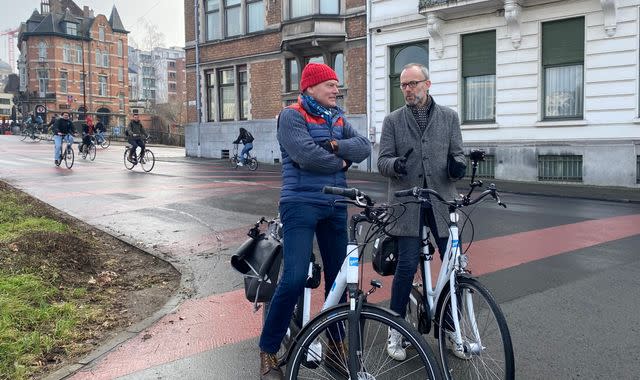How Belgian mayor faced down death threats to make his city's transport go green

In the Belgian city of Ghent they have achieved little less than regime change, taking the crown from the car.
But it was a brutal fight, according to Filip Watteeuw, deputy mayor and architect of the city's mobility and circulation plan.
"It was a very rough debate, with death threats for me and my family. And so I had six weeks of police surveillance. It was very difficult, but it was worth it," he says.
In cities across Britain, similar transport plans are on the books, provoking harsh reactions.
In Oxford, Bristol, Bath, Cambridge, London, Newcastle, Gateshead and more besides, councillors are wrestling with ways of making their urban areas less polluted and less congested whilst healthier and more climate-friendly.
Click to subscribe to ClimateCast with Tom Heap wherever you get your podcasts
So The Climate Show went to Ghent, a city of approaching half a million people. A city transformed by a travel plan in 2017.
Getting off the train, we saw an area the size of a football pitch covered in parked bikes: cycling has doubled in the six years since the transport plan came in. We then took a packed tram into the city centre: public transport use is up 12% too.
But the real surprise comes in the placid feel of the place: major junctions thronged by carefree pedestrians and crazy multi-occupancy bikes, the minimal traffic dominated by white vans and taxis, as they are some of the few vehicles allowed in.
'The plan was to make short journeys less attractive for a car'
So how has this been achieved? I caught up with deputy mayor Filip as he cycled around his city.
"The plan was to make short journeys less attractive for a car and more attractive for anything else," he says.
The centre of the city is largely barred to vehicles, but suppliers, some health workers and elderly residents are allowed to drive. Outside of that, it is now impossible to drive directly between six surrounding suburbs: you have to go out to the ring road, round and back in, to your destination.
A similar approach is planned for Oxford. Going by car is still possible but much less convenient, making the bus, the bike or walking more attractive by comparison and faster than before.
'I hear the birds in the morning'
"The most beautiful compliment I ever got was that someone said you are the best city composer because for the first time since living here, I hear the birds in the morning," Filip says.
But some changes are only apparent with a historical eye.
What is now a park with shrubs, sculptures and, somewhat bizarrely, built-in mini trampolines, was a car park. They even freed the Reep river from underground imprisonment under another car park. The nearby houses have become waterfront properties.
Not everyone is convinced
Not all inhabitants are converts.
Walter is delivering fresh drinks and frozen food to the city's many restaurants. As he struggles to pull his pallet trolley across cobbled streets, he complains that politicians don't understand working people, about their newly restricted delivery times and what he sees as a new menace: careless cyclists.
"They don't have lights, they ride with no hands, they're on their phones, they drive all over the road," he says.
But Filip believes the plans are popular.
He says: "The opponents are always very loud. But the people who are in favour of such a plan, they are mostly silent, they support you, but you don't hear them.
"And if you are in politics, you should have a policy for your city. It should be a policy for the people of the city. Not for the cars."

 Yahoo News
Yahoo News 
